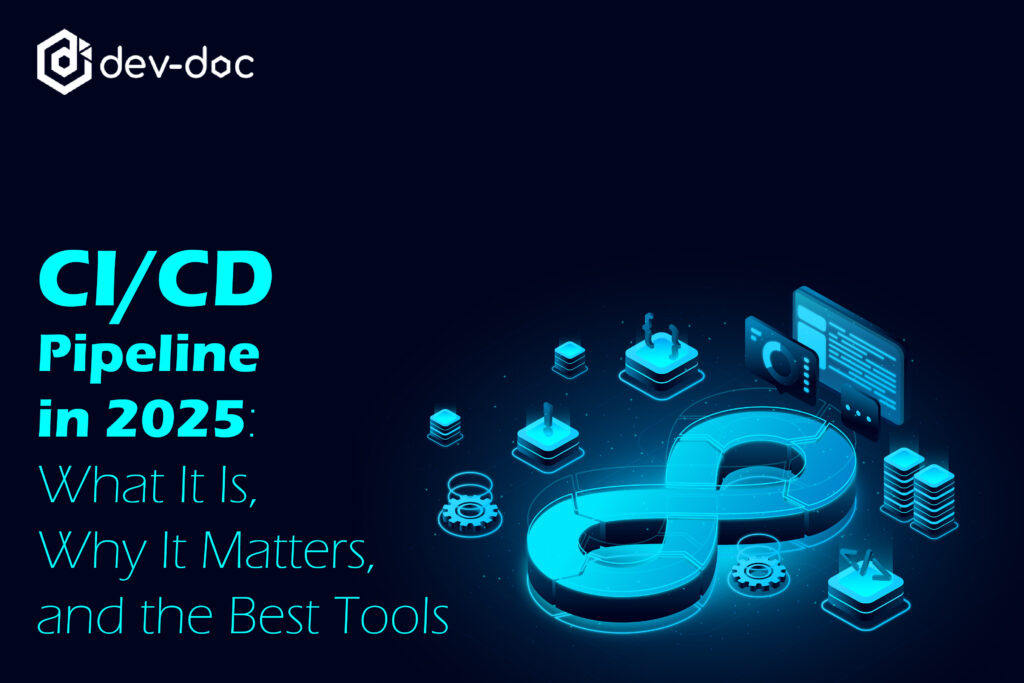This blog explores what a CI/CD pipeline is, why it’s essential in modern software development, and the top tools you can use to build smooth, scalable, and effective pipelines.
What is CI/CD Pipeline?
The CI/CD pipeline, also known as the continuous integration and continuous deployment pipeline, is an automated series of DevOps workflows that streamline the software development process from code creation to deployment. It helps software teams build, test, and deploy code faster and more reliably.
The CI/CD pipeline combines two main practices:
1. Continuous Integration (CI)
In this phase, a shared repository (e.g., GitHub, GitLab) is used to merge code changes made by developers. Each merge triggers automated builds and tests, ensuring bugs, conflicts, or integrations are detected early.
2. Continuous Deployment/Delivery (CD)
Once the code passes the CI phase, it is automatically prepared for the release. The responsible team member, like the project manager or team lead, can then decide when to deploy it to final production.
With a CI/CD pipeline, developers spend less time fixing errors means more time in development and improvement.
Why to Use CI/CD Pipeline?
The CI/CD pipeline makes software delivery faster, safer, and more reliable. Here is how:
Faster Delivery
CI/CD Pipeline allows you to automate the entire process of building, testing, and deploying, reducing the release cycle from weeks/months to hours/day. It helps to deliver features, bug fixes, and security patches quickly.
Early Bug Detection
When you commit, the CI/CD pipeline automatically triggers automated builds and tests. This quick automated action helps to detect issues immediately, saving time and cost by fixing problems before the final production.
Higher Quality Software
CI/CD Pipeline enforces coding standards (e.g., linting, static analysis, text coverage). It automates the testing process, ensuring that only stable, reliable code gets deployed. CI/CD reduces human error compared to manual deployments.
Improved Developer Productivity
The CI/CD Pipelines allow developers to spend less time on manual builds or deployment steps. It makes the feedback loop faster, letting developers know within a minute if their code breaks something. This approach frees engineers to focus on new features, not fixing broken environments.
Enhanced Security (DevSecOps)
The CI/CD Pipelines allow you to build security scans (e.g., SAST, DAST, dependency checks) within the pipeline. It manages secrets and credentials centrally (not hardcoded). Compliance requirements such as PCI, HIPAA are easier to enforce in the CI/CD pipeline.
Scalability & Team Collaboration
In CI/CD pipelines, multiple developers can commit and integrate code without conflicts. Teams working parallel get immediate feedback if change conflict. CI/CD pipeline scale as the project grow, supporting microservices and large repos.
10 Best CI/CD tools for 2025
Let’s take a quick dive into the top 10 CI/CD pipeline tools shaping 2025
GitLab CI/CD
Quick Overview
GitLab CI/CD is a fully integrated, built-in continuous integration and continuous deployment solution within GitLab’s DevOps platform, allowing your team to automate code builds, tests, and deployments all from within a single DevOps platform.
Key Features
- Full DevOps pipeline from version control, CI/CD, monitoring, and more.
- Automatic CI/CD pipeline configuration based on your application.
- Supports integrating Docker and Kubernetes for containerized applications.
- Security testing integrated into the pipeline
- Native integration with GitLab repositories.
Pros
- All-in-one DevOps solution (source control, CI/CD, monitoring)
- Easy setup with GitLab-hosted runners
- Strong built-in security scanning
- Efficient for both small teams and large enterprises.
Cons
- Can be resource-intensive for smaller teams
- Some advanced features are only available in premium plans.
- Limited to GitLab users
Jenkins
Quick Overview
Jenkins is a widely used, most popular, and open source automation server, well-known for its flexibility and extensive plugin ecosystem. It’s perfect for teams wishing a customizable, scalable, and extensible CI/CD platform.
Key Features
- More than 1800 plugins for integrations with almost every tool used in software development.
- Comes with
.Jenkinsfileallows teams to define build, test, and deployment pipelines as code. - Supports any programming languages and technology stack.
- Highly customizable build workflows.
Pros
- Highly customizable and open source.
- Supports almost all the version control systems and integrations.
- Fully scalable.
Cons
- Highly customizable and open source.
- Supports almost all the version control systems and integrations.
- Fully scalable.
CircleCI
Quick Overview
CircleCI is a modern cloud-hosted CI/CD tool well-known for its speed, scalability, and developer-friendly workflows. It provides a scalable continuous integration (CI) and continuous deployment/delivery tool for teams of all sizes.
Key Features
- Provides native support for Docker and Kubernetes. supporting container-based workflows.
- Supports parallelism and caching for faster builds (Running multiple tasks simultaneously).
- Easy integration with a version control system like GitHub, Bitbucket.
- Provides insights and Analytics, showing performance metrics to help teams optimize their CI/CD pipelines.
- Allows teams to define complex workflows and dependencies.
Pros
- Highly optimized for speed.
- Supports parallel execution.
- User-friendly interface.
- Integration with cloud services.
Cons
- Limited features for free users.
- Limited support.
GitHub Actions
Quick Overview
GitHub Actions is GitHub’s native, powerful, and fully integrated CI/CD tool that lets developers automate workflows directly from their GitHub repositories. It’s ideal for GitHub-centric teams, looking for a simple yet flexible solution for CI/CD pipelines.
Key Features
- Integrate directly inside GitHub repositories without any third-party tools.
- Define workflow configuration in a fully customizable YAML-based file.
- Able to run tests on multiple configurations or versions in parallel
- Supports containerized and VM-based builds.
- Marketplace with thousands of pre-built actions.
Pros
- Built directly into GitHub.
- Easy to set up with reusable workflows.
- Free for public repositories.
- Flexibility and customizability.
Cons
- Limited documentation.
- Steep learning curve.
Azure DevOps
Quick Overview
Azure DevOps is a cloud-based DevOps tool by Microsoft, offering repositories, pipelines, testing, and deployment services.
Key Features
- Provides full capabilities for CI/CD pipeline from version control to deployment.
- Seamless integration with Azure for cloud-based applications and services.
- Supports multiple programming languages, frameworks, and platforms.
- Azure Pipelines with cloud-hosted and self-hosted agents
- Integration with GitHub, Bitbucket, and Azure Repos
Pros
- Full set of tools for CI/CD Pipeline.
- Great integration with the Microsoft ecosystem
- Flexible deployment option
Cons
- Complex setup and configuration.
- Can be expensive for small.
TeamCity
Quick Overview
TeamCity is a powerful CI/CD tool by JetBrains designed for enterprises, offering deep integrations with JetBrains tools and extensive customization. It combines continuous integration with testing and deployment automation, making it perfect for teams of all sizes.
Key Features
- Works on almost all platforms.
- Supports complex build configuration with a multi-step process.
- Integrates with version control systems like GitHub, GitLab, and other version control systems.
- Seamless integration with cloud platforms like AWS and Google Cloud.
- Support for multiple frameworks and languages.
- Plugin ecosystem for extended functionality.
Pros
- Highly flexible for complex workflows and configurations.
- User-friendly.
- Robust build and test management.
- Strong IDE integration.
- Detailed reporting and build insights.
Cons
- Costly.
- Not much scalable.
- Steeper learning curve.
TravisCI
Quick Overview
Travis CI is a popular cloud-based CI/CD service designed to automate the software testing and deployment process, with a focus on GitHub integration.
Key Features
- Enables direct integration with GitHub repositories for seamless CI/CD pipelines.
- Supports a wide range of programming languages.
- Runs multiple tests at a time (Parallel Testing).
- Pre-built deployment projects
- Extensible with plugins
Pros
- Free for open-source projects.
- Easy to use and minimal configuration
- Strong community support.
Cons
- Paid. Some feature requires a paid plan.
- Limited parallelism for the free plan.
- Slower builds compared to newer platforms.
Semaphore
Quick Overview
Semaphore is a cloud-based, developer-friendly CI/CD platform known for its speed and scalability. It is designed to accelerate the development process with real-time feedback and parallel test execution.
Key Features
- Able to run multiple tests and builds in parallel.
- Supports Docker and Kubernetes.
- Provides scalable cloud-based infrastructure.
- Allows the team to define customized workflows for complex pipelines.
Pros
- Faster builds.
- Supports containerized applications.
- Scalable for growing teams.
Cons
- Smaller ecosystem compared to GitHub Actions or Jenkins
- Limited free usage
AWS CodePipeline
Quick Overview
AWS CodePipeline is a fully managed CI/CD service from Amazon Web Services. It automates the process of building, testing, and deploying applications on AWS infrastructure. AWS CodePipeline also enables developers to trigger builds and run tests from third-party locations.
Key Features
- Use JSON templates to define the pipeline.
- Capable of initiating custom functions within a pipeline using AWS Lambda.
- Supports third-party CI/CD tools like Jenkins and TeamCity, via plugins.
- Native integration with AWS services (CodeBuild, CodeDeploy, Lambda, ECS, etc.)
- Visual pipeline editor for easy workflow design
Pros
- Seamless integration with the AWS ecosystem
- Scales automatically with project needs
- Cost-effective (pay per pipeline execution)
- Highly secure with IAM-based access control.
Cons
- Best suited only for AWS-centric projects
- Limited flexibility compared to Jenkins or GitLab
- Complex UI for new users
Bitbucket Pipelines
Quick Overview
Bitbucket Pipeline is a native CI/CD service by Atlassian, built directly into Bitbucket Cloud. It’s an add-on to Bitbucket Cloud that allows developers to automate builds, testing, and deployments without needing an external tool.
Key Features
- Native integration with the entire Atlassian suite.
- Provide DORA metrics to measure DevOps success.
- Configuration as code.
- Pre-built templates for common workflows.
- Integration with Jira and Trello.
Pros
- Simple and easy setup directly inside Bitbucket.
- Strong Atlassian ecosystem integration.
- Great for lightweight pipelines.
- Pre-built templates for a quick start.
Cons
- Limited advanced customization.
- Not as feature-rich as GitHub Actions or GitLab CI/CD.
- Performance issues may occur for complex pipelines.
Final Thoughts
In 2025, the CI/CD pipelines are not something just “nice-to-have”; they’re the unavoidable component for modern software delivery. From small teams pushing updates daily to enterprises managing complex deployments across clouds, CI/CD Pipeline ensures speed, reliability, and security at scale.
Whether you choose GitLab CI/CD for its all-in-one DevOps platform, Jenkins for ultimate flexibility, GitHub Actions for seamless GitHub integration, or AWS CodePipeline for cloud-native automation, the right tool depends on your team’s size, budget, complexity, workflow, and ecosystem.
However, crystal-clear and well-organized documentation is crucial at every stage of the development process—especially when tests fail due to unexpected errors, issues arise during deployment, or when a new team member joins in the middle of a project.
Tools like Dev-doc elevate the overall documentation process, making it easier to create, maintain, and update documentation that stays in sync with your project progress.
If you still have any questions or require any additional support. Feel free to contact us anytime.

